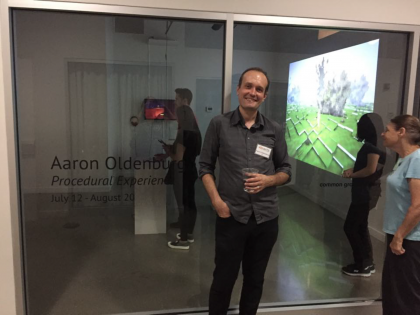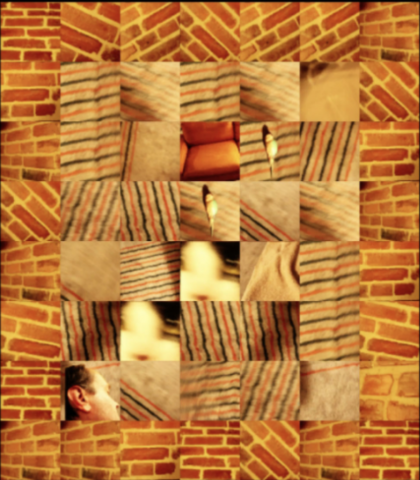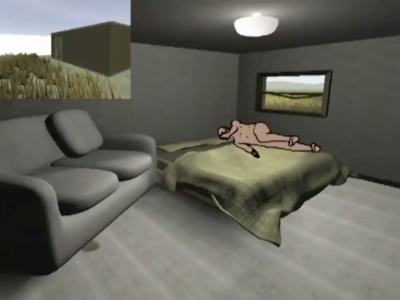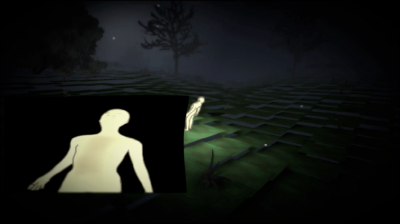
By Noa West, VisArts Summer Intern, 2017
Aaron Oldenburg is a game designer and new media artist. He presented a series of experimental video games in his first solo exhibition at VisArts, Procedural Experience, July 12 – August 27, 2017.
The element of interactivity is a unique facet of contemporary art that has been explored in a variety of mediums. As the breadth of game design continues to expand, the artist, as game designer, has the ability to create a simulation of time and space through the virtual medium. A video game is a simulation of a moment, an experience, or an alternative reality. From my conversation with Aaron, I learned that a player does not always have control over their avatar. Games can be virtual experiences that force the player to see through the eyes of the avatar. In order to understand game design as an art medium, I did some research. One of the most interesting discoveries was a game called That Dragon, Cancer, released in 2015. Ryan Green, the game designer, based the game around his young son who was battling terminal brain cancer. Green launched the game while he was in the hospital with his son, who, at the time, was in pain. No matter what he did to aid his son, whether reading to him, rocking him, or attempting to give him water, his son would not stop crying. This painful memory is simulated in the game, which requires the player to undergo a similar experience of consoling a child, that might cause one to feel agonizing emotion. Games have the potential to not only simulate memories, but also to recreate experiences. Many indie game designers, including Aaron Oldenburg, are interested in engaging a player’s empathy. Aaron’s work interconnects empathy, philosophy, culture, and activism.
Interestingly, Aaron’s love for social work has permeated his work as a game designer. Experiences working at the HIV/AIDS Hotline in Tallahassee, Florida, as well as an HIV Health Extension Agent for the Peace Corps in Mali, West Africa, helped turn him into a multidimensional artist. Now, he is able to express his interest in exposing different stories and perspectives through an alternative medium. Aaron teaches this game design medium at the University of Baltimore, where he contributes to the proliferation of video games in the art world.
How do you define a ‘game’?
I’ve kind of fallen on different sides of this. There are a bunch of definitions; one that I used to go by was it must have goals, consequences, obstacles, and an end state that’s unpredictable. I felt it was important because it gave you an expressive vocabulary that other art forms do not have, and you can use that. Ian Bogost talks about procedural rhetoric, and the way games communicate their ideas is through the mechanics, by what they cause you to do. In my games, I have gone the opposite direction, feeling like our job is really to create obstacles. I felt like I
did not need to go through the whole checklist of everything of what a game has to be like in my work, and by doing that it’s not a “full game” and it’s not making the most of all the vocabulary that games have. Some of the most interesting things that call themselves games are either not doing one of those things or doing the opposite of what’s conventionally being considered a game. Some of those only make sense if you call them a game, because they are intentionally breaking those rules. It’s not really helpful to restrict a game definition because there is so much interesting stuff happening that would get ruled out if you kept it restrictive.

Can you elaborate on rules that you ‘break’ as an indie game designer?
Instead of saying “breaking rules,” I should have said “breaking with expectations of the game format.” For instance, in the game Thinning, the gameplay initially looks like that of a standard “rogue-like style” game, a generally 2-D procedurally generated dungeon crawler. But as one moves through the rooms, instead of encountering monsters to kill, the camera zooms out, showing the same room repeated, with the player character moving in the same patterns through seemingly infinite rooms. These repeating rooms turn into curving patterns, and eventually the player is not focused on controlling their character, but navigating this world turned into patterns through empty space. It’s an attempt to give the player a sense of depersonalization, and it helps the experience if the player begins with the expectations of the
particular type of game into which they’re initially dropped. A sillier example is my game Furrowed Brow, which is a wearable game attached to a wig, that takes the form of one of those games where you are supposed to catch a falling object. Only the game itself decoratively replaces the furrows in the player’s actual forehead with an animated line in the game, so it is unclear whether the purpose is to play or to display the game as a costume. In general though, many of my games eschew the “overcome a challenge to achieve the goal” style of play.
What are aspects and perspectives that game designers and artists have in common? Do you think their goals converge?
Well, as a solo game designer, I end up playing the roles of visual artist, musician/sound designer, and narrative designer, and each of these have similar processes to their non-game variants. I think where they diverge, generally, is that game design is a process of opening up and letting go, more so than in some other art forms.
Because your games are not a part of the ‘gamer’ demographic, what is your target audience?
People who play weird games like me. (Laughs)There’s a subset of videogame-players, some of whom identify as “gamers,” some who don’t, who are interested in games that are somewhat smaller, more personal or experimental than mainstream indie games. These games have most recently come under the term “altgames.”
Has your experience in social work intervened with your approach in game design?
I think so, yeah. I have previously made connections between counseling and my work. Before I worked for the Peace Corps in Mali, I was a counselor for the HIV/AIDS Hotline in Tallahassee, Florida, for five years. Through that experience, I have found parallels between social work and being a game designer. When you are a counselor or therapist, someone could come to you with problems. You are listening to them, reflecting back to them, and at some point, you might say to yourself, “I kind of know what they need to do,” but if you tell them exactly, they’re not going to have a sense of agency-there’s not going to be a sense of ownership over the decision to make a certain change in their life or something like that. So, as a counselor you kind of have to lead. Though they might not go in that direction, you help direct them where they need to go without explicitly stating. A game designer is kind of a similar thing. You have a sense of what you want the player to do, but if you tell them explicitly it’s not going to be interesting. In order to direct the player, you add sneaky things to get them to have a more interesting experience.
How has religion, possibly philosophy, culture and empathy, shaped your practice?
As an atheist, I obsess about these existential questions so I really do describe this game as an agnostic encounter with a belief system, which really thinks about the significance and purpose of a person when they are gone and how they will impact you. In the game After, your character is tending to your dying partner. After they die, your partner becomes a second set of eyes, not only guiding you to finish the game, but as a metaphor for guiding you through your life. The game demonstrates that people who have passed still have an impact and influence on present decisions. These games have somewhat traditional game mechanics and turn them on their heads to show how a part of the world works. At the time that I was creating the game, I was really interested in the proceduralist style of Ian Bogost, which is more about ambiguity and broken questions rather than answers.

You will be displaying the game Cho-Am in Procedural Experience. What inspired you to create this game?
Cho-Am came out of some really conflicted feelings after visiting Pol Pot’s grave in Cambodia. Pol Pot (1925-1998) was leader of the Khmer Rouge communist movement in Cambodia from 1975 to 1979. In efforts to create a classless peasant society, Pol Pot was responsible for the death of over 1.5 million people, who died from starvation, forced labor, execution, and disease. He died before he was brought to justice. (Click more for details: http://www.history.com/topics/pol-pot ) Before venturing to Pol Pot’s gravesite, I heard that there were a lot of people treating it like a shrine, not because they wanted to commemorate him, or for him to be worshipped, but because he was so powerful-his aura could help people with their fortune. There was a storyabout a businessman from Thailand who had Pol Pot appear to him in a dream, and proceeded to give him lottery numbers. So, the man visited his grave and built a spirit shrine around him. That story really intrigued me because it falls outside of how we think about people’s legacy. Pol Pot was a terrible person, as he was responsible for so many millions of people dying, and yet many people still have a willing relationship with him, which comes out of a totally left-field angle, and does not address his detrimental impact. So, using my documentary processes to develop game design, I decided to go over there and interview some people, to investigate what this was all about. When I visited, I decided to formulate a game around the space itself, once I actually found it.

Pol Pot’s grave is a barren cremation site, where there is almost nothing there. I really like those kinds of sites, the lack of stimuli provokes imagination and emotion. When I was there, I took a ton of pictures and audio from the environment. The site itself evoked a lot of emotion within me. While I was there, I started to feel an ambiguous spiritual experience. I knew that I wanted to create a game that was inspired by this, but at some point in the process it started to feel sort of icky. As a Westerner, I felt like the game I was conceiving was using someone else’s tragedy for my spiritual experience. Initially going in, I knew that it was going to be a touchy subject. It’s genocide, but feeling like there is a history of documentarians going to a place, getting people to talk, and making something out of it, is a valid thing. So, in the game, I decided to leave situations kind of unresolved. In the game the player is an ambiguous sleepwalker—they could be a tourist, a victim, civilian or even Pol Pot wanders around the site. Dream-like mundane images from the life of Pol Pot come to them and alters the sleepwalker’s movements. The sleepwalker has sort of unpredictable gestures, as a part of an interest of mine, which is that the player is trying to understand the psyche of the avatar. The gestures developed from research I did on trauma and post-traumatic stress. And then I left it simply at that, because it felt uncomfortable with the original concept. I like it more like this. The gestures play off of the messages that the sleepwalker receives. I read about how people who were suffering from post-traumatic stress from Cambodia would have nightmares where you can’t even get up, as if someone was sitting on you. In general, the game is sort of a strange evocation of trauma.
Do you think that the message of your games changes when they are in a gallery setting
versus a traditional console?
It’s been interesting to see that the game audience has changed and broadened; years ago, you couldn’t find anyone who was interested in playing weird games. Now there’s plenty of creative things on steam. You see the audience maturing a little bit, and I’ve seen in galleries stuff that I see outside of galleries. There’s a certain level of freedom that a gallery space has— you have the leeway to make mistakes. Failure is sort of encouraged and/or appreciated in sort of a different way. In a gallery, if you make a really interesting mistake, feedback would support keeping it. At the same time, gallery spaces showcase the game world and the glitch aesthetic, so I think that there is some crossover, and not totally exclusive to one or the other.
Because video games/video art have an accumulated history since its conception and
development 40+ years ago. How have video games as art become progressively legitimized?
If we just talk about the contemporary art world, I think the history of sound art, performance,and the interdisciplinary artist group Fluxus, have all helped make a place for videogames. Artist John Cage’s 4’33 was revolutionary in creating work emphasizing chance and audience produced content. Overall there is wider support, as more and more exhibitions are dedicated solely to games nowadays.
You are a professor at the University of Baltimore teaching this medium, what conceptual
processes have you exposed to your students?
Mainly my students come into game design from a conventional perspective. I teach a game design class called Frontiers of Game Design, where last semester we did all audio-only games.They had to create games where the player figured out where they were, and what they had to do in their environment without any visual cues. That caused them to make really interesting things when they had those kind of restraints.
How can you tell if it is a “good” game (in comparison to a “good” painting?)
Oh boy, that’s hard, because recently a very good game came out called Mountain that was very much like a painting. I mean, for me, they have similar requirements, that they stick with you long after you’ve experienced them.
To interact more with Aaron’s work, visit www.aaronoldenburg.net
